It’s hard to imagine that any of Chicago’s 29 miles of lakefront would be available for development in 2005. It’s even harder to believe that a lakefront parcel is currently the largest vacant lot in the entire city.
But a roughly 578-acre site fitting the above description sits in the South Chicago neighborhood, about 10 miles south of downtown, and community leaders say it will have a major impact on a key portion of the South Side.
The land is east of South Shore Drive, the southern extension of Lake Shore Drive, and smack dab on the lake. In conjunction with Westrum Development Company of Pennsylvania, Chicago developer Dan McCaffery intends to turn around 400 acres of that vacant land – the former South Works site of U.S. Steel – into a mixed-use community of housing and retail.
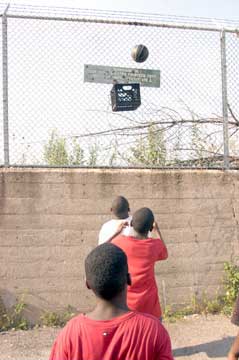 Plans are still on the drawing board, and McCaffery, president of Chicago-based McCaffery Interests, says they won’t have weight until the city approves them, but the broad outlines of the redevelopment have been in the works for years.
Plans are still on the drawing board, and McCaffery, president of Chicago-based McCaffery Interests, says they won’t have weight until the city approves them, but the broad outlines of the redevelopment have been in the works for years.
“My plans are inconsequential at this point,” McCaffery says, “but the development could include anywhere from four (thousand) to six thousand units. We’re very hopeful to be able to get to a position that will allow us to present it to the city in the next four to five months.”
After that, the planning and approval process could take up to a year. McCaffery says that construction could last another five to seven years, although of course, that schedule will be subject to the vicissitudes of the market and the exigencies that inevitably arise with such a massive project.
One thing is certain in the proposed development: 100 to 125 acres of McCaffery’s 400-acre parcel will be donated back to the city by the developer for park and shore land. Somewhere, Daniel Burnham is smiling.
Hugging the lakeshore at 79th Street and slinking all the way down to 87th Street, McCaffery’s parcel sits directly east of “The Bush” section of South Chicago, and directly south of Rainbow Beach and the South Shore Country Club. Like much of Chicago’s lakefront, the former U.S. Steel land is not original; it is composed of slag, a byproduct of the steel-making process.
“It’s amazing,” says Pete Scales, communications director for Chicago’s Department of Buildings. “It’s like a big prairie out there the size of the loop. They poured this slag and it kind of has the texture of lava rocks. The parcel has a lot of weeds and grasses that have taken over, and it really looks kind of beautiful right now, like a natural prairie. And off to the north there is a great view of the skyline.”
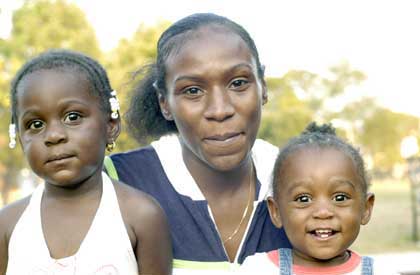 The city suffered a setback when Solo Cup Company recently dropped its plans to build a manufacturing facility on more than 100 acres to the south of McCaffery’s planned development. Solo would have brought an influx of much needed jobs to the project, and so far there has been no announcement of another major employer to fill the gap.
The city suffered a setback when Solo Cup Company recently dropped its plans to build a manufacturing facility on more than 100 acres to the south of McCaffery’s planned development. Solo would have brought an influx of much needed jobs to the project, and so far there has been no announcement of another major employer to fill the gap.
Still, residents and community leaders in South Chicago, bounded roughly by 79th Street, 95th Street, the lake and the Chicago Skyway, say that the housing and retail components being planned by McCaffery will be a boon to a neighborhood that is already improving. According to the Southeast Chicago Development Commission, McCaffery’s development could be home to 15,000 new residents. All of this could lead to a brighter future for a neighborhood that has seen its share of economic strife and crime.
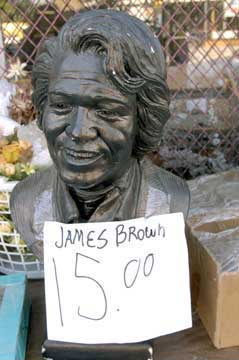 On the neighborhood’s main retail strip, Commercial Avenue, a few blocks to the west of the U.S. Steel site’s western border, restaurateur Sade Adebiyi remembers darker days. When she opened Ola Mummy’s Afrocentric Restaurant six years ago, she often had to close early because her location on Commercial Avenue made the restaurant a convenient place for pedestrians to run for cover when gang fire erupted. Next thing she knew, her dining room would be filled with police officers asking questions.
On the neighborhood’s main retail strip, Commercial Avenue, a few blocks to the west of the U.S. Steel site’s western border, restaurateur Sade Adebiyi remembers darker days. When she opened Ola Mummy’s Afrocentric Restaurant six years ago, she often had to close early because her location on Commercial Avenue made the restaurant a convenient place for pedestrians to run for cover when gang fire erupted. Next thing she knew, her dining room would be filled with police officers asking questions.
“It was all gangs when I first opened,” says Adebiyi, a native of Nigeria who moved here 12 years ago. “Now, you have more businesses opening, and a LaSalle Bank branch and a Bank One.”
A portion of the strip, between 88th and 92nd streets, has even been designated as a pedestrian shopping street by the city. Some rundown storefronts have been spiffed up with new awnings and replicas of antique light fixtures, giving the retail district the feel of a small town’s main drag. Colorful banners adorn street light poles.
The goal of the Southeast Chicago Development Commission is to attract national retailers that will thrive alongside the businesses of local entrepreneurs. The organization does not want to see the mom-and-pop stores replaced with corporate chains.
At 83rd Street and Jeffery Avenue, for instance, a gleaming new Kentucky Fried Chicken restaurant complements the old Celebrity Lounge across the street, a friendly bar where a DJ spins “dusties” for “stepping,” an African American dance tradition.
The city has promised tax increment financing on Commercial Avenue in an effort to attract new businesses.
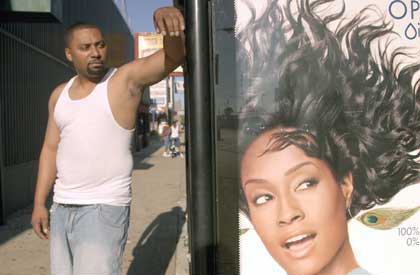 Overall, Adebiyi says, Commercial Avenue is cleaner, and feels safer than it did even a few years ago. And the diversity of its businesses creates a charm that newer neighborhoods, with their cookie-cutter franchises and formulaic architectural design, will never know. But the retail strip still has a long way to go, if you ask Neil Bosanko, the author of an editorial in the summer 2005 edition of the South Chicago News Flash, a neighborhood newsletter.
Overall, Adebiyi says, Commercial Avenue is cleaner, and feels safer than it did even a few years ago. And the diversity of its businesses creates a charm that newer neighborhoods, with their cookie-cutter franchises and formulaic architectural design, will never know. But the retail strip still has a long way to go, if you ask Neil Bosanko, the author of an editorial in the summer 2005 edition of the South Chicago News Flash, a neighborhood newsletter.
“Take a good look at all of the misspelled signs advertising products quite visible in the window,” Bosanko writes. He goes on to say that it is the responsibility of business owners, not the city, to keep their storefronts clean. “It’s about time that our owners take some initiative on their own to take pride in their source of income! With all of the wonderful development happening in our region, it surprises me that these same owners do not realize that they are cutting themselves off from potential business for simple reasons, such as aesthetics, that can easily and economically be corrected.”
Just a few doors south of Ola Mummy, on Commercial Avenue, a tidy restaurant specializing in authentic African cuisine, is Polka Catering, both testaments to the neighborhood’s longstanding tradition as a port of entry for immigrants.
For more than a century, immigrants flocked to the area seeking jobs in the steel mills, which first arrived in 1875, when the Brown Steel and Iron Company opened a mill on the Calumet River. Over the next quarter century, steel mills sprouted throughout the area and pushed beyond the border into Indiana. In 1900, a young United States Steel Corporation, which already owned the South Works plant, built Gary Indiana as a town for workers.
South Chicago became one of the world’s great centers for steel production, and the giant companies that dominated the neighborhood made their presence felt in myriad ways – the least subtle being the cloud of black smoke that perpetually hung over the neighborhood and the infernal blast furnace flames that lit the night sky with an eerie glow.
Conditions were often harsh, and pollution long has been a serious concern in South Chicago and surrounding neighborhoods. The problems cause by the mills, however, were mild compared to the economic impact of layoffs and closures that began in the ’70s.
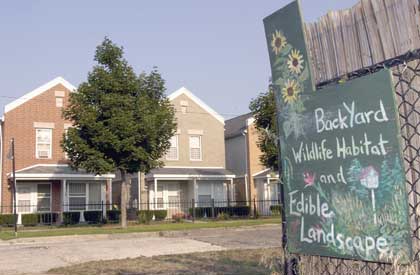 The mills are gone and the population has shifted, but remnants of the neighborhood’s Eastern European roots remain in places like Polka Catering, a butcher shop with a pressed-tin ceiling and an old-time signboard featuring delicacies such as duck soup and blood bacon, along with several other offerings that only a connoisseur of Eastern European food would recognize (If you must know, we’re talking about Thuringer, black jelly, serdelova and bolszewik). The prices at Polka are Old World, too; they’ll make you a sandwich while you wait for $2.99. Polka also will put together a deli tray for you, and it is fitting that the shop’s advertising flyer includes the phrase “For Home, Office or Plant.”
The mills are gone and the population has shifted, but remnants of the neighborhood’s Eastern European roots remain in places like Polka Catering, a butcher shop with a pressed-tin ceiling and an old-time signboard featuring delicacies such as duck soup and blood bacon, along with several other offerings that only a connoisseur of Eastern European food would recognize (If you must know, we’re talking about Thuringer, black jelly, serdelova and bolszewik). The prices at Polka are Old World, too; they’ll make you a sandwich while you wait for $2.99. Polka also will put together a deli tray for you, and it is fitting that the shop’s advertising flyer includes the phrase “For Home, Office or Plant.”
It’s proof that South Chicago, though changing, is still an industrial pocket of the city with a decidedly urban feel (despite the emerging quaintness of Commercial Avenue), and has been for more than a century.
The U.S. Steel plant closed in 1992, but the Port of Chicago is nearby, and operating as usual. And the elevated Chicago Skyway, with its endless trucks whooshing by, is a constant reminder that no matter how much parkland is developed on the lakefront, this is an area that will have a blue-collar identity for years to come.
This part of the city is where Bears legend Dick Butkus came from.
Enough said?
If not, how about South Chicago area native Chris Zorich, the former Notre Dame football star who went on to play for his hometown Bears then put himself through law school? He has become the personification of the blue-collar work ethic for Chicagoans, a product of Chicago Vocational High School (as is Butkus), who beat the odds through hard work and determination.
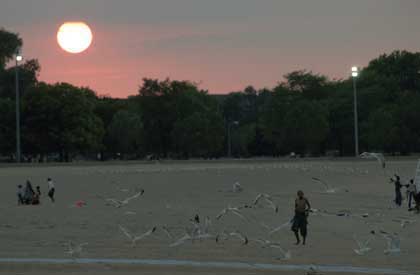 Perhaps South Chicago will follow Zorich’s example, as it slowly and steadfastly attempts to better itself. The neighborhood has never fully recovered from the hit it suffered in the 1970s when the steel mills that were the biggest providers of jobs for area residents began to sag, and the economy at large began to close in on itself.
Perhaps South Chicago will follow Zorich’s example, as it slowly and steadfastly attempts to better itself. The neighborhood has never fully recovered from the hit it suffered in the 1970s when the steel mills that were the biggest providers of jobs for area residents began to sag, and the economy at large began to close in on itself.
Even before McCaffery was involved with the redevelopment of the U.S. Steel parcel, neighbors had their own ideas about what to do with the land. They commissioned a massive study, McCaffery says, and called it “Steel Town to Hometown.” McCaffery tracked down copies of the study, and considered the neighbors’ ideas when formulating his own master plan.
“I’m hopeful that they will be pleased that we emulated so much of what they had originally proposed,” McCaffery says. “We’re being very careful to make sure that our development is integrated with the neighborhood.”
McCaffery is also responsible for several other high-profile developments, including Nike Town on North Michigan Avenue; the rehab of the Reliance Building (which was transformed into Hotel Burnham) on State Street, in the loop; and the Bernardin, a new boutique apartment highrise at the corner of Chicago and Wabash avenues.
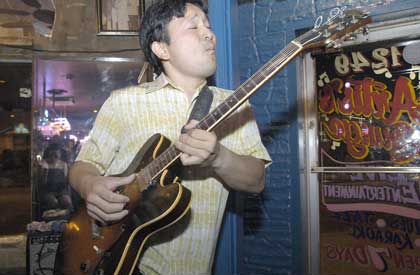 The South Chicago project, of course, is in an entirely different league. It has the scale not just to enhance a neighborhood, but to help redefine it.
The South Chicago project, of course, is in an entirely different league. It has the scale not just to enhance a neighborhood, but to help redefine it.
Realtor Margie Smigel of Hyde Park-based Metro Pro sees South Chicago as a sort of diamond in the rough, a long-neglected place with great potential. She believes that a well executed development on the lake could have the power to reinvent the entire area.
“The big issue always on the South Side is that if people don’t think they can get their money out, they wont put it in,” she says. “And in blighted neighborhoods, the banks won’t loan people money. But if there’s a great development going on two blocks away, then all of a sudden, those houses on the edge of that development will get done, and the ones beyond them will follow. Hopefully there will be that ripple effect and the neighborhood will come back.”
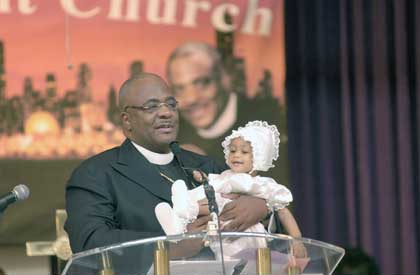 Smigel says that a residential renaissance could also lead to a retail renaissance, as is often the case. But commercial benefits aside, she points out, the rare opportunity presented by new low-rise housing on the lakefront in a neighborhood of streets lined with trees instead of skyscrapers.
Smigel says that a residential renaissance could also lead to a retail renaissance, as is often the case. But commercial benefits aside, she points out, the rare opportunity presented by new low-rise housing on the lakefront in a neighborhood of streets lined with trees instead of skyscrapers.
“It’s extraordinary,” she says. “Who lives on the lake anymore except for people in towers?”
